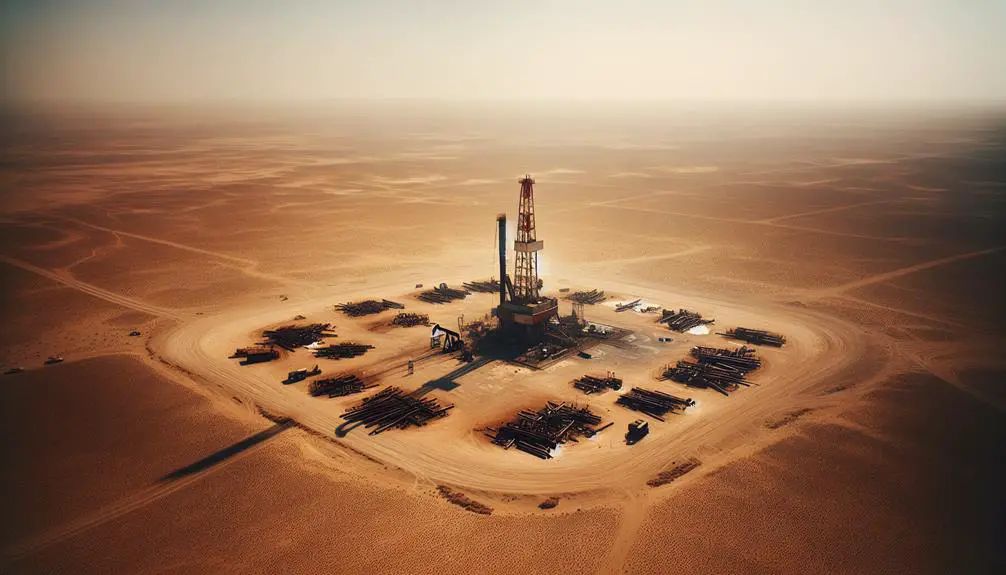Deserted oil drilling sites are abandoned due to various factors. Environmental risks like soil contamination and habitat destruction pose threats to ecosystems. Economic challenges, such as high operational costs and market fluctuations, affect sustainability. Obsolete technology at these sites raises safety concerns and hinders efficient operations. Moreover, the historical significance and legal responsibilities surrounding abandonment play significant roles. Understanding these aspects provides a holistic view of why such sites are left behind.
Key Points
- Economic challenges like high operational costs contribute to site abandonment.
- Environmental degradation from abandoned sites poses risks to ecosystems and wildlife.
- Technological obsolescence hinders efficient site rehabilitation and reactivation.
- Legal responsibilities, such as compliance with regulations, impact site abandonment decisions.
- Historical significance and cultural heritage considerations influence the abandonment of oil drilling sites.
Environmental Impact of Abandoned Sites
The environmental degradation caused by abandoned oil drilling sites is a pressing concern that requires immediate attention and remediation. These sites often pose significant risks to ecosystems and wildlife due to factors such as soil contamination, habitat destruction, and water pollution. Ecological restoration efforts are vital in mitigating these impacts and restoring the affected areas to a semblance of their original state.
Wildlife conservation becomes an essential component of addressing the aftermath of abandoned oil drilling sites. The presence of toxic substances in soil and water can have detrimental effects on local fauna and flora, disrupting entire ecosystems. Implementing strategies to protect and rehabilitate wildlife populations in these areas is crucial in ensuring the long-term sustainability and biodiversity of the region.
Economic Challenges Faced by Operators
Amidst the complexities of the oil industry, operators often encounter formidable economic challenges when managing abandoned drilling sites. These challenges arise due to various factors that impact the financial aspects of site management. Here are four key economic challenges faced by operators in dealing with deserted oil drilling sites:
- Operational Costs: Maintaining abandoned drilling sites involves significant operational expenses such as site security, regular inspections, and potential environmental cleanup, leading to a strain on financial resources.
- Market Demands: Fluctuations in oil prices and market demands can directly affect the economic viability of reactivating abandoned sites. Operators must navigate these market dynamics to determine the feasibility of reviving operations.
- Asset Depreciation: Over time, the value of abandoned drilling equipment and infrastructure depreciates, further adding to the economic burden on operators when considering site rehabilitation or decommissioning.
- Financial Liabilities: Operators may face financial liabilities associated with abandoned sites, including regulatory compliance costs and potential legal obligations, impacting their overall financial health and sustainability.
Technological Obsolescence in Oil Drilling
Operators managing abandoned oil drilling sites must confront the challenge of technological obsolescence in oil drilling, which presents a critical hurdle in site rehabilitation and operational viability. The presence of outdated equipment, no longer aligned with current industry standards due to the rapid evolution of technology in oil drilling, raises concerns regarding safety, efficiency, and environmental impact.
Outdated equipment poses risks, potentially leading to malfunctions or accidents during operations, further complicating the already challenging task of rehabilitating abandoned sites. Additionally, the inefficiencies associated with obsolete technology can hinder the economic feasibility of reviving these locations for oil exploration.
As the oil drilling industry continues to advance, embracing new technologies and methodologies, the gap between legacy equipment at deserted sites and modern industry standards widens. This technological mismatch underscores the need for strategic planning and investment in upgrading equipment to align with current practices.
Overcoming technological obsolescence is paramount to ensuring the sustainable and safe reintegration of abandoned oil drilling sites into operational use.
Historical Significance of Forgotten Sites
Exploring the abandoned oil drilling sites reveals a rich tapestry of historical significance waiting to be uncovered and preserved for future generations. These forgotten sites hold valuable insights into the past, shedding light on the cultural and industrial heritage of the regions where they're located. Here are four key aspects of the historical significance of these abandoned drilling sites:
- Archaeological Exploration: These sites offer a unique opportunity for archaeological exploration, providing a glimpse into the technological advancements and working conditions of the past.
- Cultural Heritage: The structures and remnants found at these sites are a proof of the cultural significance of oil drilling in shaping local communities and economies.
- Industrial Evolution: Studying these abandoned sites helps trace the evolution of oil drilling technology and its impact on the industrial landscape over time.
- Cultural Preservation: By documenting and preserving these sites, we can make sure that their historical value isn't lost to time, contributing to the cultural preservation of our collective heritage.
Legal Issues Surrounding Abandonment
Legal considerations surrounding the abandonment of oil drilling sites encompass a complex web of regulations and responsibilities that dictate the proper handling and management of these inactive facilities. When oil drilling sites are abandoned, various legal implications come into play. Companies are typically required to adhere to specific guidelines established by regulatory bodies to guarantee environmental protection and public safety. These regulations may include proper well plugging and abandonment procedures, site remediation requirements, and financial assurances to cover potential cleanup costs.
One of the primary legal implications of abandoning oil drilling sites is the financial responsibilities that companies bear. They're often obligated to set aside funds or provide financial guarantees to cover the costs associated with decommissioning and restoring the site to its original condition. Failure to comply with these financial responsibilities can result in legal consequences, including fines and penalties. Hence, understanding and meeting the legal obligations surrounding site abandonment is essential for companies operating in the oil and gas industry.
Frequently Asked Questions
What Happens to the Wildlife That Used to Inhabit Deserted Oil Drilling Sites?
When oil drilling sites lay deserted, wildlife finds itself displaced, with ecosystems disrupted. Efforts for habitat restoration and conservation are essential to mitigate the ecological impact. By understanding and supporting these initiatives, you can help preserve biodiversity.
How Do Abandoned Sites Affect Local Water Sources and Groundwater Quality?
Abandoned oil drilling sites have a significant impact on local water sources and groundwater quality. The contamination from these sites can lead to water pollution, affecting ecosystems and potentially endangering human health.
Are There Any Efforts to Repurpose or Rehabilitate Abandoned Oil Drilling Sites for Alternative Uses?
Rehabilitation initiatives at abandoned oil drilling sites present sustainable development opportunities. Efforts focus on repurposing land for renewable energy projects or biodiversity conservation. These endeavors aim to restore ecosystems and benefit local communities through innovative solutions.
Do Abandoned Oil Drilling Sites Pose Any Health Risks to Nearby Communities?
Abandoned oil drilling sites carry potential contamination risks, impacting nearby communities. Community outreach is essential to assess and address health hazards. Vigilance and remediation efforts are necessary to safeguard public health and the environment from these abandoned sites.
How Do Abandoned Sites Contribute to Climate Change and Emissions of Greenhouse Gases?
When abandoned, oil drilling sites can contribute to climate change by releasing greenhouse gases. To mitigate this, focus on land restoration and carbon sequestration. Embracing renewable energy sources is essential for emissions reduction.



